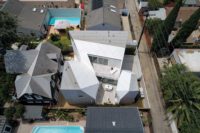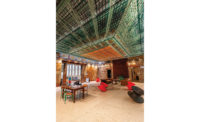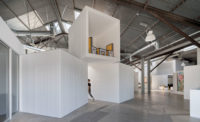Los angeles may be the first city to have taken plywood seriously as a finished material, a fact that was not lost on architects David Freeland and Brennan Buck when they designed the interior for Earl's Gourmet Grub. Opened in May 2010 in an empty 1,500-square-foot storefront on an otherwise nondescript section of Venice Boulevard about three miles northwest of the beach, Earl's is the kind of casual restaurant that Los Angeles does so well. Polished ground-concrete floors and plywood mix with glass and marble and organic comfort food, all to fresh effect.
The two architects met as graduate students at the University of California, Los Angeles, and then worked separately for a few years before founding their firm, FreelandBuck, in 2009. So they readily acknowledge debts to the Los Angeles school, particularly to the use of plywood in the early projects of Frank Gehry and Thom Mayne. But there are nuances evident in the design of Earl's that distinguish Freeland and Buck as part of the digitally connected, theory-based generation of young architect-academics behind a small-scale revival of craft. If allusions to the Los Angeles school occur'Freeland previously worked for Michael Maltzan, while Buck taught with Greg Lynn'they certainly don't dominate.
At Earl's, the architects responded to a client interest in Alpine imagery and rustic food with an environment made by bending, warping, and fusing planes in subtle ways and with hints of restrained color. 'We are interested in finding a set of material effects and details that, through their method of fabrication and construction, produce atmosphere,' Freeland says of the abstract Alpine landscape mural in wood that covers the long west wall of the restaurant. To extend the flat surface of the white maple veneer wall into low relief, the architects depended on Rhino and Grasshopper software and a computer numerical controlled (CNC) mill (see related story, page 99). Buck describes this surface interest as part of a wider investigation into what digital technology and fabrication can contribute to architecture, rather than a fascination with technology for its own sake.
The mural plays against a white gypsum-board wall on the east that bends up into baffles at the ceiling over the kitchen. Two layers of warped '-inch gypsum board in semi-gloss white form three large, central light scoops over the open kitchen's bar'two with electric light and one, above the cash register, with an actual skylight. The scoops contribute to a sense of scale, bringing the ceiling down to a human size and subdividing the space. They also provide some acoustic softening to the open kitchen area. The bar's mitered marble corner details blur the panels into a single monolithic block, so that the kitchen more effectively dominates the restaurant. The bathroom has its own surface effects where a painted mural depicts a tree. But it is only recognizable when viewed from one angle. When looked at from other vantage points, the tree appears more like a random pattern.
As for that Gehry-style plywood, the architects used it in several ways, including in the street-side sign that forms the underside of an eating bar in the front window and along the east wall. In the ceiling above the mural, the architects designed a series of plywood baffles that conceal T5 fluorescent strip lights installed along the wall like a continuous light fixture. At floor level, built-in plywood millwork for displaying packaged food and for casual seating lines the west wall. In all cases, Buck and Freeland specified a bleaching process to minimize contrasts between growth rings in the plywood, while a white stain softens the sheets further and relates more closely to the white maple mural.
It appears the plywood has been taken seriously: The architects won a restaurant design award from the AIA Los Angeles chapter in July and are at work on two other restaurants in the region. With each new project, the firm has developed a better understanding of the tools of fabrication, particularly CNC mills, says Freeland. Or as Buck says, 'I think we're developing a weird hybrid between the physicality of materials and the digital processes we use to manipulate them.'
Cost: $220,000
Completion Date: May 2010
Gross Square Footage: 1,000 sq.ft.
Architect and Designer:
FreelandBuck
2404 Wilshire Blvd, Suite 9E
Los Angeles, CA 90057
55 Washington St, Suite 333
Brooklyn, NY 11201
(323) 540-4346
(323) 570-0846 fax
PeopleOwner: Yvonne McDonald and Dean Harada Architect: Personnel in architect's firm who should receive special credit: Brennan Buck, Partner Other: Joe Cooper - CNC milling General contractor: Vandermeer General Contractors Photographer(s): Lawrence Anderson |
ProductsHardware Interior finishes Paints and stains: Dunn Edwards semi-gloss white paint Paneling: CNC milled White Maple Veneer Mural (design by FreelandBuck) Solid surfacing: Marble countertops Floor and wall tile: Sealed concrete Lighting Downlights: Lightolier |








Post a comment to this article
Report Abusive Comment